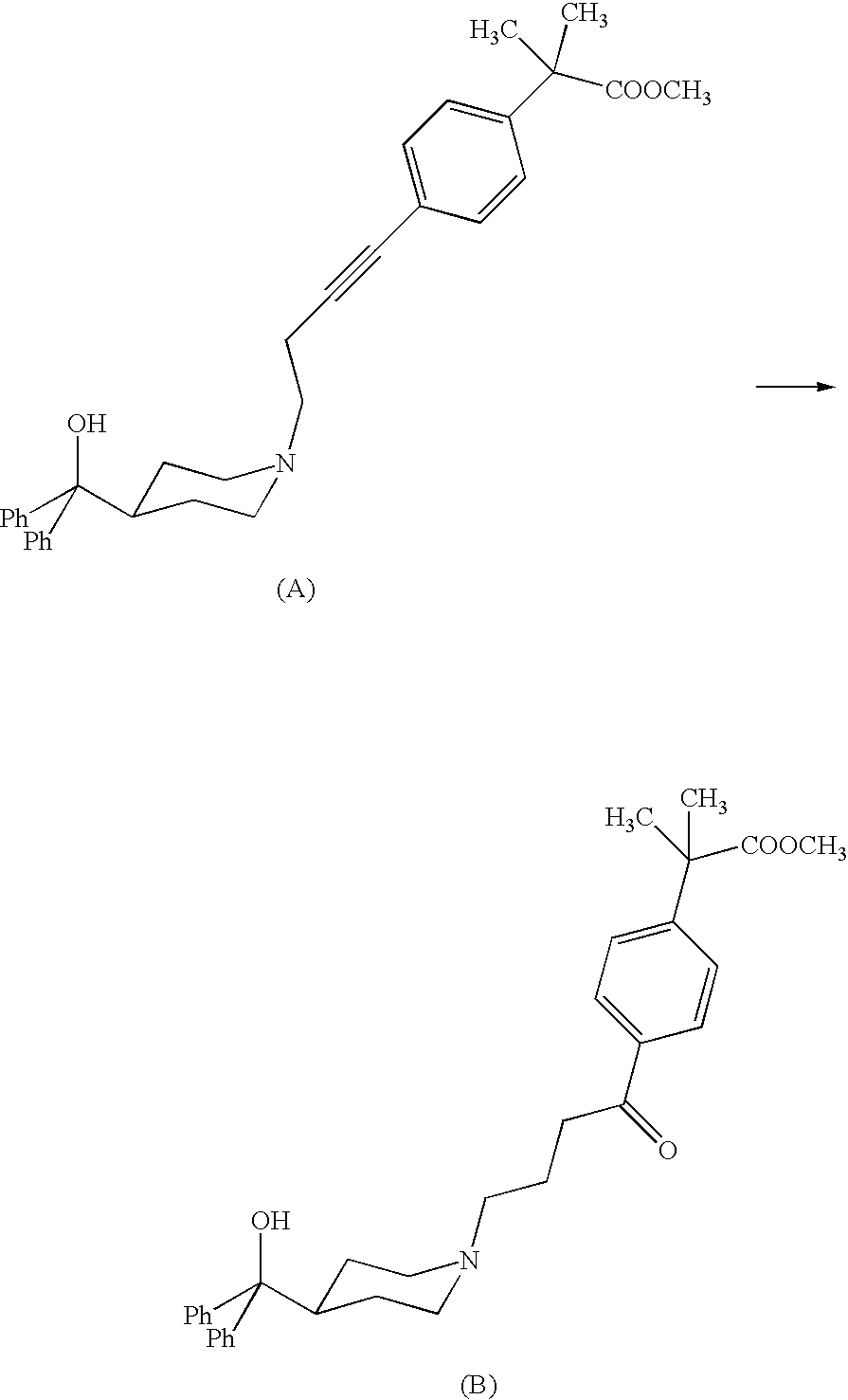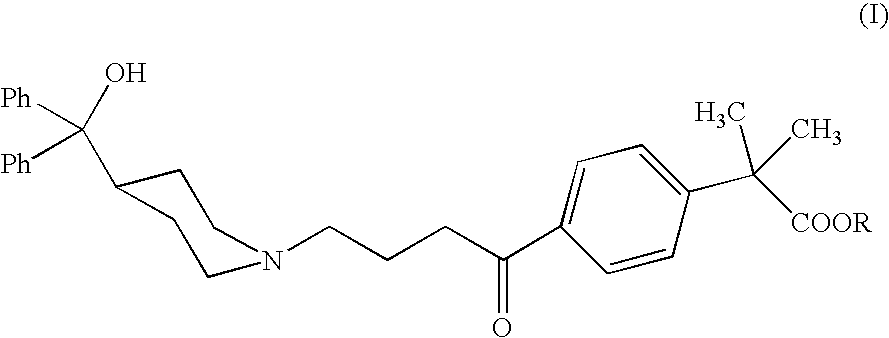Process for the preparation of keto intermediates
a technology of keto intermediates and ketones, applied in the field of synthetic intermediate preparation, can solve the problems of troublesome protic acid results, difficult industrial scale formation of regioisomers, and low yield of surprisingly high yields
- Summary
- Abstract
- Description
- Claims
- Application Information
AI Technical Summary
Benefits of technology
Problems solved by technology
Method used
Image
Examples
example i
Synthesis of methyl 4-{[4-(4-hydroxyphenylmethyl)-1-piperidinyl]-1-oxobutyl}-α,α-dimethylbenzenacetate (I, R=Me)
[0042]The alkyne of formula II (R=Me) (200 mg, 0.40 mmol) is dissolved in absolute ethanol (0.8 ml) and then treated with monohydrate p-toluenesulfonic acid (383 mg, 2.02 mmol). After 10 minutes, Ph3AuCl (4 mg, 0.0081 mmol, 2% molar) and AgCF3SO3 (2 mg, 0.0081 mmol, 2% molar) are added. After 48 h, at room temperature, the ethanol is evaporated under reduced pressure and the residue is taken up with ethyl acetate and basified till pH 10-11 with a NaHCO3 solution. The phases are separated, and the aqueous one is extracted with ethyl acetate. The organic phases are collected, dried with Na2SO4, filtered off and evaporated under reduced pressure. The crude reaction is purified by flash chromatography (acetate / methanol 9:1 as eluent) and 198 mg of title keto compound are obtained as a white solid, with a yield of 95%.
[0043]1H NMR (400 MHz, CDCl3) δ ppm: 7.94 (d, J=8.5 Hz, 2H),...
example 2
Synthesis of 4-{[4-(4-hydroxyphenylmethyl)-1-piperidinyl]-1-oxobutyl}-α,α-dimethylbenzenacetic acid (I, R=H)
[0044]The alkyne of formula II (R=H) (2.0 g, 4.16 mmol) is dissolved in ethanol (8 ml) and then treated with monohydrate p-toluenesolfonic acid (3.9 g, 20.8 mmol). After 10 minutes Ph3PAuCl (41 mg, 0.083 mmol, 2% molar) and AgCF3SO3 (21 mg, 0.083 mmol, 2% molar) are added. After 24 h, at room temperature, the ethanol is evaporated off under reduced pressure and the residue is taken up with THF. The reaction mixture is heated and basified with a NaOH solution. The phases are separated and the organic one is treated with acetic acid. The white crystallized solid is filtered off and dried. 1.97 g of the title product (I) are obtained with a yield of 95%.
[0045]1NMR (300 MHz, CDCl3) δ ppm: 7.70 (d, J=8.4 Hz, 2H), 7.52-7.46 (m, 6H), 7.32-7.26 (m, 4H), 7.20-7.15 (m, 2H), 3.47 (s, 1H), 3.37 (m, 2H), 2.74-2.63 (m, 4H), 2.55 (m, 1H), 2.39-2.32 (m, 2H), 2.03-1.78 (m, 4H), 1.58-1.52 (m, 8...
example 3
Synthesis of 4-{[4-(4-hydroxyphenylmethyl)-1-piperidinyl]-1-oxobutyl}-α,α-dimethylbenzenacetic acid (I, R=H)
[0046]The alkyne of formula II (R=H) (50.0 g, 0.104 mol) is dissolved in tetrahydrofuran (225 ml) and treated with 62.5% sulfuric acid (81.5 g, 0.519 mol), dropwise added. After 30 minutes water (10 g), Ph3PAuCl (1.03 g, 2.1 mmol) and AgNO3 (0.36 g, 2.1 mmol) are added. The reacting mixture is heated to 45° C. and maintained at the same temperature for 18 h under stirring. The mixture is then diluted with water and basified with a 30% NaOH solution at around 40-50° C. The mixture is maintained under reflux for 16 h under stirring and then filtered on charcoal. The solution is neutralized by addition of acetic acid and cooled to 5-10° C. under stirring. The crystallized solid is filtered off and dried. Title product (I) is obtained (41.0 g) with a 79% yield and more than 99% purity calculated by HPLC.
[0047]1H NMR (300 MHz, CDCl) δ ppm: 7.70 (d, J=8.4 Hz, 2H), 7.52-7.46 (m, 6H),...
PUM
| Property | Measurement | Unit |
|---|---|---|
| Ph | aaaaa | aaaaa |
| organic | aaaaa | aaaaa |
Abstract
Description
Claims
Application Information
 Login to View More
Login to View More - R&D
- Intellectual Property
- Life Sciences
- Materials
- Tech Scout
- Unparalleled Data Quality
- Higher Quality Content
- 60% Fewer Hallucinations
Browse by: Latest US Patents, China's latest patents, Technical Efficacy Thesaurus, Application Domain, Technology Topic, Popular Technical Reports.
© 2025 PatSnap. All rights reserved.Legal|Privacy policy|Modern Slavery Act Transparency Statement|Sitemap|About US| Contact US: help@patsnap.com



